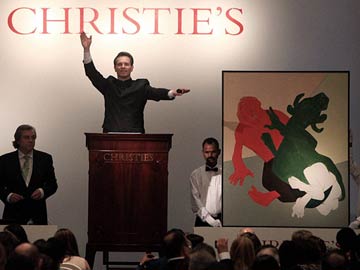 |
| Gambar Hiasan |
Art as an investment
BY THEAN LEE CHENG
Art means different things to people living in different eras in different places. Much of the work done by artists in centuries past were commissioned by the wealthy or by the church. They wanted a more ornamental ceiling or their beloved captured on canvas in an era when the camera was yet to be invented.
And so artists like Rembrandt, Leonardo da Vinci and many others, went to work. And as society and the world evolved, their works eventually became known as art, like the bison on the cave walls of the pre-historic man.
Not all of what you value may be works of art. Not every piece you pay good money for is art. Man is naturally drawn to beauty, or their perspective of what is pleasing to the eye. And this is where the word “collection” comes in.
As a child enjoys looking at her collection of shells, an art collector derives pleasure in a piece of “art”. And so their respective collection begins as an appreciation.
Along the way, when money is involved, it becomes an investment. Man has a tendency to want things to go up and that includes what they have collected.
The wealthy have become the preservers of art and this includes Malaysian individuals like architect, the late Datuk Kington Loo, and Malaysia’s first woman ambassador and Southeast Asian Ceramic Society chairman Datuk P G Lim. Bank Negara Malaysia is the biggest corporate collector.
For centuries, works of art have been bought, collected and auctioned throughout the Western world, says artist Dr Jolly Koh, who spent a good many years studying and later lecturing abroad.
 |
| Gambar Hiasan |
Koh
“There is something vulgar talking about art as an investment. There is a clear distinction between the price of art and its investment value. A piece of art, or painting, can cost RM100 or RM10,000.”
Koh, an artist from the 1960s and among the first to have formal art education abroad asks rhetorically: “Why is art expensive? And what is its investment value? You cannot conflate them. They are two different questions.
“Art is expensive because in any society, only the upper echelons value art. They value beauty. Art gives expression to the society’s values and core beliefs. Different art gives different expressions.”
Koh says whether a piece is expensive or cheap is relative. High art is expensive relatively to a person’s salary of RM2,000 a month. Art is not expensive relative to a BMW.
Koh says people here will buy a BMW but will balk at spending RM20,000 on a painting.
If one were to compare Malaysian art to a contemporary in Europe or Australia, the latter would be about triple or 10 times the price.
National Art Gallery director Rahime Harun says Malaysian art lacks demand for various reasons, chiefly because of the absence of an active secondary auction market.
“We do not have to go far for comparison. Look at Indonesia,” he says.
According to Christie’s Hong Kong, the highest value of a painting by an Indonesian artist ever sold by Christie’s was Raden Sarief Bastaman Saleh’s The Deer Hunt which went S$3.08mil in March 1996.
This compares with the highest value of a painting by Malaysian artist, Siew Hock Meng’s Dancer with Gamelan Orchestra, which went for S$73,612 (including premium) last April
As for works by Latiff Mohideen, the highest value, which Christie’s sold, was S$40,250 (including premium) for the Pago Pago series in October 1998.
Says Rahime: “Indonesia has an active auction market since 1930s and this is obvious when one compares prices of Indonesian and Malaysian works.
The lack of channels of distribution in Malaysia, however, does not mean art has no investment value. It is an untapped asset class.”
So how does one approach art?
“You must like it. Malaysians like bright, pretty colours and photographic works. They don’t like abstract.
“Whatever it may be, you are going to hang it on a wall and allow it to be a source of emotional sustenance and pleasure. You display it for your enjoyment. (On the other hand) You keep an investment in a safe deposit box,” says Koh.
Koh says art with potential investment value could cost between RM10,000 and RM20,000 a piece.
“Ask around. Who are the artists with pieces that are underpriced? Overpriced? Do some research and after 10 to 20 years, if it is a blue chip, there is a good chance of it having good investment value. That is how one should approach art,” says Koh who has made art his business for decades.
Those who have regular exposure have seen the value of their works increase. The works of Ibrahim Hussein, Chuah Thean Teng, Yong Mun Sen and Latiff Mohideen, for example, fetch better prices than others because of this reason.
Hussein Ibrahim’s work was priced between RM6,000 and RM9,000 in the early and mid 1970s. They now cost hundreds of thousands.
Chuah’s works were priced about RM3,000 in the 1970s but are RM30,000 and above today. Prices, he says, are not arbitrary.
“We must create an inclination for people to collect and enjoy art. The oil companies used to collect but no more.
“Today, the biggest collectors are banks. Besides an active auction for the secondary art market, Malaysia also needs a society to value them before they come under the auctioneer’s hammer, and an art collectors’ club,” says Rahime.
Note: Christie’s Hong Kong Spring 2005 sale of Southeast Asian and Chinese paintings, jewellery and watches and other works of art will be held at Hong Kong Convention & Exhibition Centre, Wanchai, Hong Kong between May 29-June 1.





 Latif Maulan
Latif Maulan





0 comments:
Post a Comment